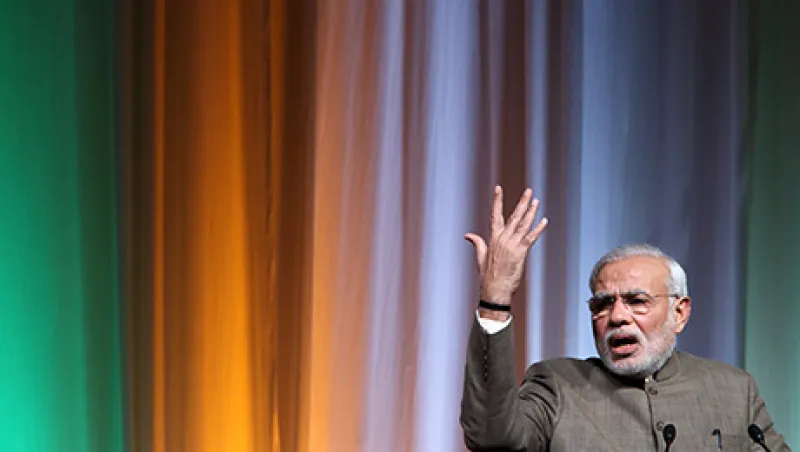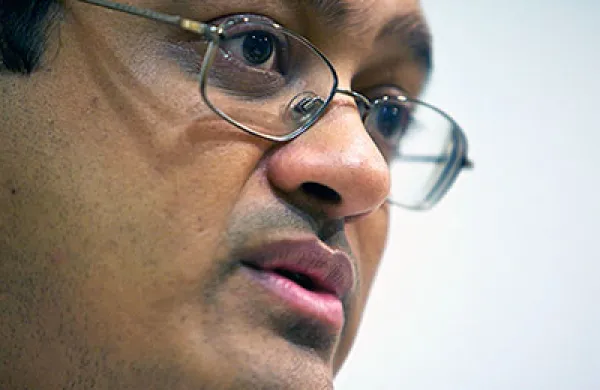The murmurs of Modi mania that began earlier this year turned into a resounding roar in May when Narendra Modi, chief minister of the state of Gujarat, swept the country’s general election to become prime minister. The politician’s business-friendly, reform-minded campaign promises elicited a strong response from financial markets. The S&P BSE (Bombay Stock Exchange) SENSEX index has leaped by 29 percent since the beginning of March, when it started to become clear that Modi’s Bharatiya Janata Party would prevail.
If Modi succeeds in translating his pro-business intentions into concrete action, India’s economic growth has a strong chance of bouncing back from its lackluster recent levels.
Yet even investors who hold a bullish long-term view of the Indian market acknowledge that there is, so far, a lack of eye-catching reforms to which they can point. “They need to throw a little bit to investors in terms of policies,” says Sam Gupta, chief executive and investment officer of Grand Trunk Capital Management, an investment fund based in Menlo Park, California. The absence of big policy changes “has been a disappointment, and the onus is on the administration to show how new policies will be implemented over the next couple of years,” he adds.
Investors might sense a bit of déjà vu in this flurry of early enthusiasm. Japan’s stock market soared in the months before and after Shinzo Abe, another economic reformer, took power in December 2012 after winning a resounding election victory by promising to reinvigorate the economy. Investors’ love affair with Abenomics, as his three-arrow plan is called, has begun to lose its passion following a sharp decline in second-quarter economic activity. Modi must deliver on his economic pledges, or the Indian stock market could fall back, just as the Tokyo market failed to maintain the early momentum of the Abe rally.
Modi has sparked some early changes, though. Gupta points to the speeding up of the business of everyday government. For example, the new administration has addressed the backlog of environmental approvals for infrastructure projects. To expedite these approvals and other government processes, “the bureaucracy has really been given its marching orders. Ministers are showing up at 9 a.m., and bureaucrats not already in the office get a nasty letter and unpaid leave,” Gupta says.
Responding to these signs of change in the air, many investors are keeping the faith by continuing to seek opportunities in Indian stocks.
These investors include Ashmore Investment Management, the London-based emerging-markets specialist. Julie Dickson, head of client portfolio management, equities, at Ashmore in London, expects corporate earnings to continue to rise. She warns, however, that earnings growth might not accelerate for another 18 to 24 months, because it will take time for the economic benefits of Modi’s reforms to be realized. Earnings growth for the 50 large-cap companies in India’s CNX Nifty index were up 19 percent year-over-year in the second quarter of 2014. The index had risen 29.7 percent this year, as of September 8.
Ashmore sees particular promise in small- and midcap consumer discretionary stocks, including those in the health care sector. Small-cap stocks currently trade at an average of about 12.8 times projected 2015 earnings, which is cheaper than most large-caps, on which international investors have focused their attention. “The cycle is turning, and more consumers are getting more money in their pockets,” says Dickson. In many developed markets, the bulk of that money will go to consumer goods and consumer experiences such as vacations. In India, where the public health care system is poor, “as your income grows, you start paying to look after your health, as well as to set up a home, buy clothing and send your children to school,” she adds.
Investors in India say that a return to the high economic growth rates of yesteryear is crucial. The International Monetary Fund forecasts that growth will rise to 5.4 percent this year from 5.0 percent in 2013, but that’s a far cry from the 8.5 percent average rate that prevailed in the second half of the 2000s. “Corporate profitability is very sensitive to economic growth,” says Nick Beecroft, Hong Kong–based portfolio specialist in Asian equities at T. Rowe Price, a Baltimore firm that manages $738 billion in assets. “In 2008 the economy grew almost 8 percent, and return on equity reached 23 percent, whereas last year gross domestic product growth slowed to 4 percent, and return on equity fell below 16 percent.” Despite recent rises, the Indian stock market as a whole trades at about 16 times forward earnings for 2015, just a tad above its long-term average of 15 and still some ways below the effective historical ceiling of 18, he notes. Given these relatively restrained valuations and the strong link between economic output and company earnings, says Beecroft, “if India’s growth can revive, we believe the market can push higher from here.”
Beecroft likes some of India’s privately owned banks, which he sees as a good beta proxy for the country’s economic growth. One he cites is Mumbai-headquartered HDFC Bank, which he calls “one of the best-managed banks in India,” with good cost control and lending practices. Its nonperforming loan ratio, at under 1 percent, is far lower than the Indian banking average of about 3 percent. Shares in HDFC closed at 1,051.65 rupees ($17.44) on September 8, up 32.3 percent since the end of 2013; the stock sports a price-to-book ratio of 4.5.
The T. Rowe Price manager isn’t focusing solely on domestic growth, though. Beecroft also likes stocks in the IT services sector, such as Infosys. IT services stocks have “lagged the broader Indian index in 2014 as they are less exposed to the reform excitement,” he notes, but they enjoy good prospects for long-term growth. These companies offer a play on a revival of the global financial services industry, whose huge IT spending is the source of much of their earnings. Infosys closed at 3,781.65 rupees on September 8, up 8.5 percent since the end of 2013.
That argument will be lost on many investors, though. For them, the Indian stock market means one thing and one thing only at the moment: a Modi mania play.
Get more on emerging markets and on equities.






